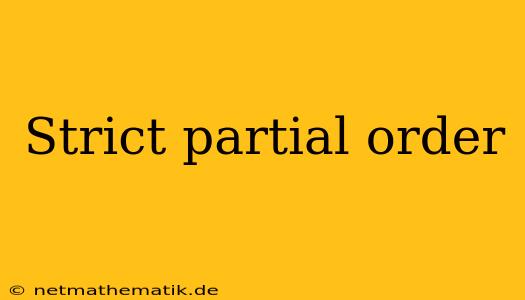A strict partial order is a fundamental concept in mathematics, particularly in set theory and order theory. It is a type of binary relation that captures the notion of a "less than" relationship between elements of a set, but without the requirement of comparability, unlike a total order. This article will delve into the definition, properties, and examples of strict partial orders, illustrating their importance in various fields.
Definition of a Strict Partial Order
Formally, a strict partial order on a set S is a binary relation denoted by "<" that satisfies the following three axioms:
-
Irreflexivity: For any element x in S, x < x is false. This means no element can be related to itself.
-
Asymmetry: For any elements x and y in S, if x < y is true, then y < x is false. This ensures that the relation is directional.
-
Transitivity: For any elements x, y, and z in S, if x < y and y < z are true, then x < z is also true. This establishes a chain-like relationship.
These axioms guarantee that a strict partial order defines a hierarchy or a partial ordering among the elements of the set, without requiring that every pair of elements be comparable.
Properties of Strict Partial Orders
In addition to the defining axioms, strict partial orders possess several other important properties:
-
Antisymmetry: If x < y and y < x are both true, then x and y must be the same element. This follows directly from asymmetry.
-
Non-totality: Not every pair of elements needs to be comparable. In other words, there can be elements x and y for which neither x < y nor y < x is true.
-
Hasse diagrams: A strict partial order can be visually represented using a Hasse diagram, which shows the elements of the set as nodes and connects them with lines representing the order relation.
Examples of Strict Partial Orders
Several common examples of strict partial orders illustrate their wide applicability:
-
The "less than" relation on natural numbers: This relation is irreflexive, asymmetric, and transitive. It is also a total order since every pair of natural numbers can be compared.
-
The "subset relation" on sets: Let S be a set of all subsets of a given set U. Then, the relation "is a proper subset of" is a strict partial order on S. For example, {1, 2} is a proper subset of {1, 2, 3}, but {1, 2} is not a proper subset of {1, 2}. This example showcases the non-totality of strict partial orders.
-
The "divides" relation on positive integers: The relation "divides" is a strict partial order on the set of positive integers. For example, 2 divides 6 but 6 does not divide 2. This relation is also not total as, for instance, 2 and 3 are not comparable.
Applications of Strict Partial Orders
Strict partial orders play a crucial role in various areas of mathematics and computer science:
-
Order theory: Strict partial orders form the foundation of order theory, a branch of mathematics dealing with the study of ordered sets.
-
Graph theory: Strict partial orders can be used to represent directed acyclic graphs (DAGs), which are graphs with no cycles. DAGs are widely used in computer science for tasks like scheduling and dependency analysis.
-
Database theory: Strict partial orders are utilized in database systems to model dependencies between data elements, enabling efficient data storage and retrieval.
-
Logic: Strict partial orders are essential for understanding the semantics of modal logic, a type of logic used to reason about knowledge, belief, and time.
Conclusion
A strict partial order is a powerful tool for representing relationships of "less than" between elements of a set, while allowing for non-comparability. Their properties and applications extend beyond theoretical mathematics, finding practical use in computer science, database theory, and logic. Understanding strict partial orders is fundamental for comprehending the structure and behavior of ordered sets, and for solving problems involving hierarchy and dependencies.
